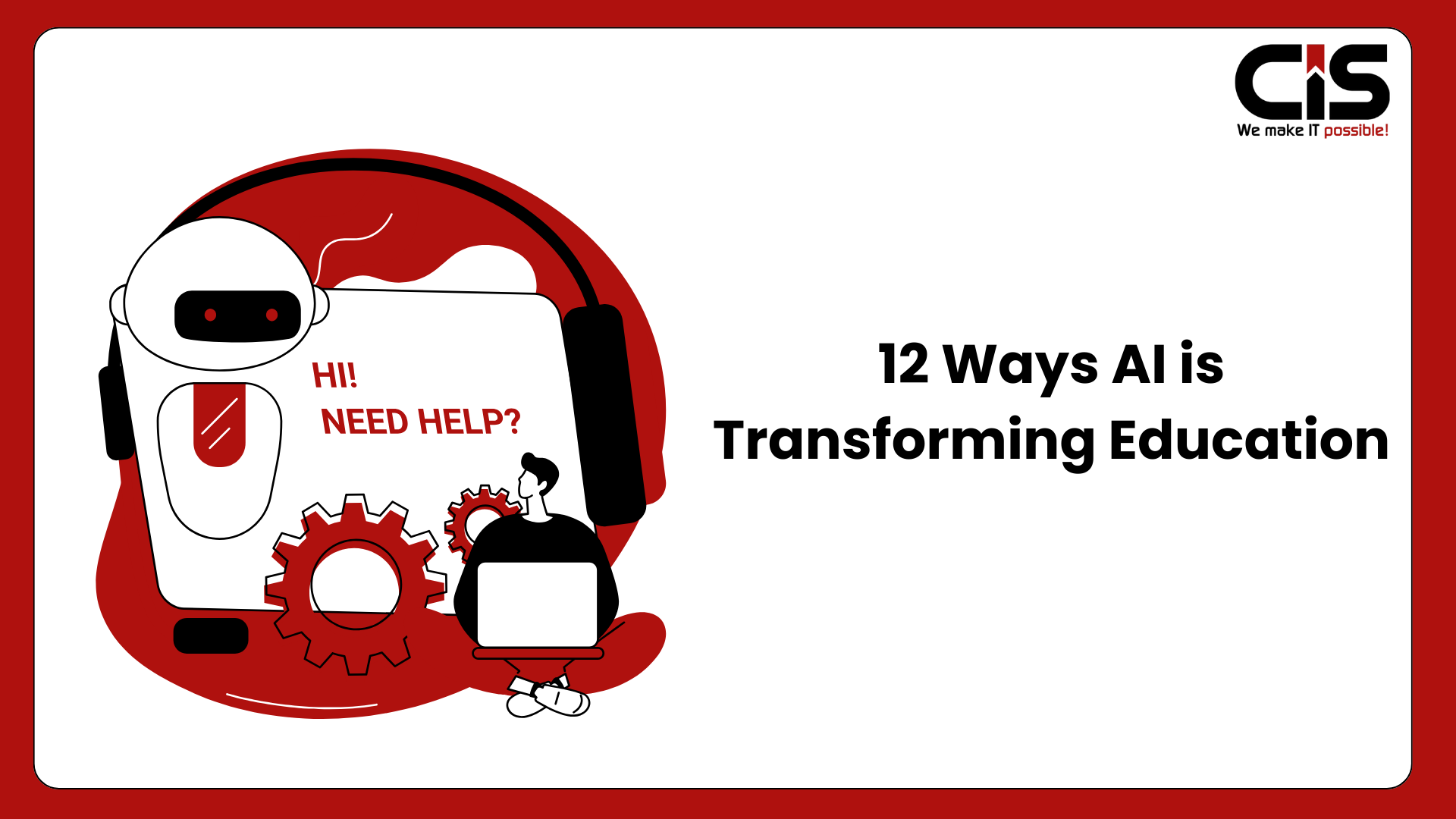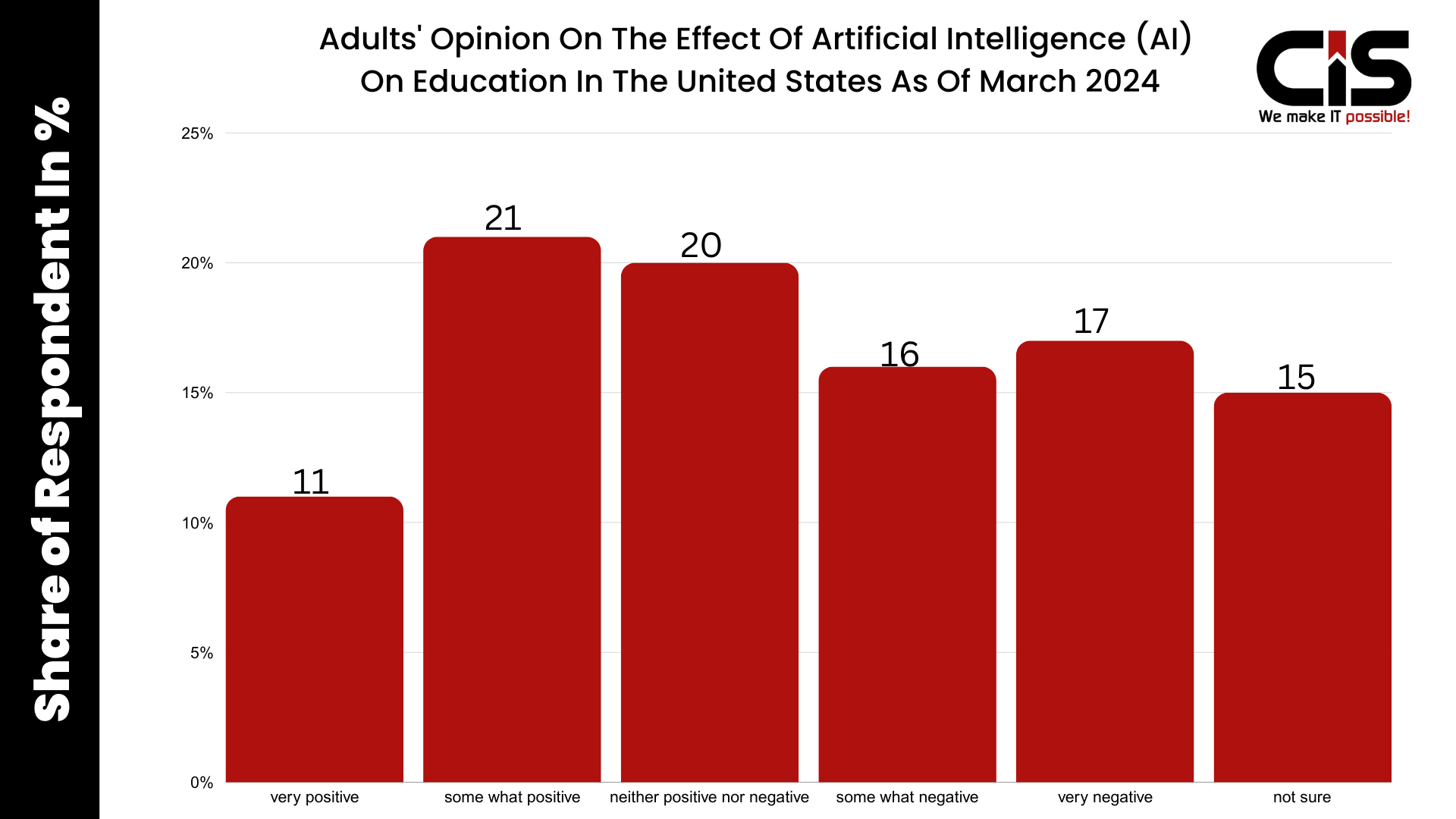The use of technology in teaching and learning has rampantly increased, and among the educators polled in the past years, 68% revealed that artificial intelligence (AI) for education has greatly influenced their instruction techniques. Mobile devices, the Internet, games, and many other tools have become the new tools of learning on which educational procedures are built.
Leading this shift is artificial intelligence for education and teaching, an enabler tool that is changing the ways of learning, teaching, and administration. Cases include analysis of big data, custom learning, and efficient assignment of work without workers' exhaustion, making AI the future of education.
The artificial intelligence market reached a value of over 184 billion US dollars in 2024, up over 50 billion from 2023, according to Statista. It is anticipated that the industry would continue to rise at an astounding rate, surpassing 826 billion US dollars in 2030.

In this article, we will look into 12 of the significant changes that artificial intelligence for education is bringing to the sphere of education. We will see how these improvements make it possible to improve learning, reduce paperwork, and improve efficiency in the classroom.
12 Ways AI is Transforming Education

Personalized Learning Experiences
According to a report from McKinsey, personalized learning can lead to a 15% increase in student achievement. Artificial intelligence tools for education play a pivotal role in creating these customized learning journeys.
Analyzing Student Performance Data
AI systems can collect and analyze data on each student's performance, engagement levels, and learning preferences, showcasing the impact of artificial intelligence for education. Here's how it works:
- Data Collection: Continuous monitoring of quizzes, assignments, and participation.
- Performance Analysis: AI identifies strengths and weaknesses through algorithms that detect patterns.
- Tailored Learning Paths: Based on performance insights, AI can curate customized lessons focusing on improvement areas.
This means students work at their own pace, receiving content that resonates with their learning style.
Adaptive Learning Platforms
Adaptive learning platforms are designed to adjust content according to a student's needs in real-time, making artificial intelligence in education a key component in modernizing the learning experience. These platforms unlock several advantages:
- Real-Time Adjustments: As students engage with the material, integrating AI modifies the complexity of tasks.
- Content Recommendations: Suggest additional resources like videos or articles to reinforce concepts.
- Immediate Feedback: Provides instant responses to quizzes, enabling quick corrections and understanding.
Intelligent Tutoring Systems
According to a recent report, 84% of educators believe that artificial intelligence for education positively impacts student learning outcomes. These AI-driven platforms, such as intelligent tutoring systems (ITS), are changing how students interact with educational resources by offering real-time personalized support.
The online learning platforms industry is expected to generate US$58.45 billion in revenue by 2024, according to Statista. Revenue is predicted to grow at a compound annual growth rate (CAGR) of 5.26% from 2024 to 2029, with a projected market volume of US$75.52 billion by that time.
What are Intelligent Tutoring Systems?
Intelligent Tutoring Systems are software applications that use artificial intelligence, demonstrating how AI can transform education for the better by providing immediate feedback and assistance to learners. They adapt to the individual student needs, adjusting the difficulty and approach based on performance.
Key Features of Intelligent Tutoring Systems:
- Real-Time Feedback: Students receive instant responses to their questions or problems.
- Personalized Learning Paths: The software tailors content based on a student's strengths and weaknesses.
- Adaptive Assessments: Tests and quizzes adjust in real time to suit the learner's current knowledge level.
- Engagement Tracking: Systems monitor engagement levels and can suggest breaks or changes in activity.
Effectiveness in Enhancing Understanding and Retention
Research shows that students using Intelligent Tutoring Systems demonstrate significant improvements in both understanding and retention:
- Higher Test Scores: A study indicated that students using ITS scored 40% higher on standardized tests than traditional learning methods.
- Improved Student Engagement: Students report feeling more engaged when using adaptive learning technologies.
- Enhanced Retention Rates: Learners using ITS were found to retain concepts longer, with studies showing a 30% improvement in long-term recall.
Read More: AI: A Game-Changing Technology? Cost, Gain, and Impact Revealed!
Automating Administrative Tasks
Recent research indicates that teachers can attend to administrative responsibilities for not less than 40% of the time they should devote to instruction. This is where artificial intelligence for education and teaching changes how administrative work, such as scheduling and grading, is done.
Streamlining Scheduling
Class schedules can be automated using various metrics to find the best possible schedule for schools and universities, thanks to artificial intelligence for education.
- Conflict Detection: AI systems can note scheduling conflicts in real-time, reducing clashes and maintaining efficiency.
- Room Allocation: Using data about how a space is used throughout the day, AI can propose the most efficient class schedules for utility and time.
- Student Preferences: AI can also help students provide a list of their most preferred times of classes, thus creating a more understanding academic schedule.
Automating Grading Processes
In grading, education for artificial intelligence can efficiently spare more time for the teachers so that they can involve themselves in other, more sensitive teaching activities.
- Quick Assessments: Multiple-choice questions can be graded at scale using an AI algorithm that saves educators from more critical work.
- Essay Evaluation: Using applications that are more developed with features of artificial intelligence, one can get a grade for a written assignment, which can also include comments on grammar, relevance, and compliance with the guidelines of a particular assignment.
- Performance Tracking: AI can take records of the student's performance and develop reports to formulate sound decisions.
Impact on Teacher Workload
Since the new ways of artificial intelligence for education take up most of the administrative duties, the burden is lifted from teachers and staff. This makes it easier for them to attend to the teaching and learning process and interact with the students.
- Time Savings: Even though teachers are forced to grade more papers and schedule more classes, less time is used in grading and scheduling, so they have ample time to prepare effective lesson plans that promote student involvement.
- Increased Efficiency: This prevents unsystematic happenings which negatively affect the operations of schools and other institutions.
- Better Resource Allocation: Management can spend more time on long-term planning and other aspects of innovation, such as improving their students' learning accomplishments rather than being tied up with paperwork.
Enhanced Student Engagement
Engagement is a crucial factor in student success. Research indicates that engaged students are 50% more likely to perform well academically. Artificial intelligence tools for education are stepping in to enhance student engagement in innovative ways.
AI-Powered Chatbots
- Instant Support: Chatbots provide students with answers and assistance 24/7.
- Accessibility: Students can ask questions anytime, making help more available than ever.
- Personalized Responses: AI can tailor answers based on the student's level of understanding.
- Data Collection: Chatbots gather insights on common student queries, helping educators address widespread concerns.
Usage Example:
Imagine a student struggling with a math problem at midnight. Instead of waiting until morning, they can use a chatbot to get instant clarification or resources. This is an example of artificial intelligence for education making learning more accessible and personalized.
Gamification Techniques
Gamification, powered by artificial intelligence for education, is revolutionizing learning. AI tools for education make teaching more interactive, while education required for artificial intelligence underscores its importance. Overall, AI can transform education for the better.
- Game Mechanics: Incorporating points, badges, and leaderboards can motivate students.
- Interactive Learning: AI can customize games based on students' learning curves, providing challenges that match their skills.
- Real-Time Feedback: Students receive immediate feedback in games, which helps reinforce learning.
Benefits:
- Increased Motivation: Students are more inclined to participate in learning when it feels like play.
- Collaborative Learning: Many gamified platforms encourage teamwork, allowing students to learn from each other.
Statistics:
- A study found that classrooms utilizing gamified elements enhance student engagement by up to 60%.
Data-Driven Insights for Educators
Data is crucial in education, with nearly 90% of educators believing it can improve outcomes. Artificial intelligence for education is revolutionizing data analysis and teaching support. Tools for artificial intelligence in education are essential, highlighting the need for education required for artificial intelligence. The AI revolution is transforming education, raising questions about its benefits and potential for improvement.
How AI Analyzes Student Data
AI systems generate insights for educators, demonstrating the value of artificial intelligence for education and tools. This shift supports education for artificial intelligence and addresses whether artificial intelligence is good for education, reflecting the AI revolution already transforming education and how AI can transform education for the better.
- Performance Tracking: AI monitors grades and assessments over time, noting trends in student performance.
- Engagement Analytics: AI can assess student engagement levels by analyzing online behaviors and interaction with course materials.
- Behavioral Insights: Patterns in attendance and participation can indicate student well-being and motivation.
Usage Example:
A teacher uses AI analytics to realize that a student with declining grades also shows reduced discussion participation. This insight, driven by artificial intelligence for education, prompts a one-on-one meeting to address potential issues.
Identifying At-Risk Students
AI helps identify at-risk students early, using artificial intelligence for education. AI tools for education and the AI revolution raise the question, is artificial intelligence good for education? Ultimately, AI can transform education for the better.
- Predictive Analytics: Algorithms assess data to predict students who may struggle academically or emotionally.
- Custom Alerts: Teachers can receive alerts for students who exhibit concerning trends, such as falling grades or increased absences.
- Targeted Interventions: Educators can implement specific strategies tailored to individual needs based on data insights.
Importance of Early Intervention
Early intervention is critical in reversing negative trends.
- Timely Support: Identifying at-risk students lets teachers intervene before issues escalate.
- Resource Allocation: Schools can deploy resources more effectively, focusing on needy students.
- Improved Outcomes: A study found that timely interventions can improve academic performance by up to 30%.
Also Read: AI in Education: Powering Billion-Dollar Learning Efficiency
Virtual and Augmented Reality Integration
Statistics reveal 60% of students prefer immersive learning. Artificial intelligence for education, along with VR and AR, enhances and personalized learning. The AI revolution already transforming education indicates AI can transform education for the better by making it more interactive and effective.
The 'AR Software' category of the AR & VR industry was expected to generate a total of 5 billion U.S. dollars (+38.58 percent) in revenue globally between 2024 and 2029, according to Statista.

How AI Enhances VR/AR in Education
AI complements VR and AR in several ways:
- Personalized Learning: AI assesses individual learning styles and performance, adapting VR/AR experiences accordingly.
- Real-time Feedback: Students receive immediate feedback through intelligent systems, enhancing their understanding of complex subjects.
- Data Analytics: AI analyzes user interactions to refine VR/AR content, improving future learning sessions.
Applications Across Subjects
VR and AR can be applied to multiple disciplines:
-
Science:
- Virtual labs where students can conduct experiments without physical limitations.
- AR apps that overlay complex molecular structures onto a textbook.
-
History:
- VR projects that simulate historical events, allowing students to "experience" history.
- AR maps that show historical landmarks in their original context.
-
Mathematics:
- Interactive 3D models help students understand geometric concepts.
- VR environments where problem-solving takes place in a virtual setting.
-
Language Arts:
- VR experiences that place students in different cultural contexts, enhancing language acquisition.
- AR tools that provide interactive story experiences in real time.
-
Art:
- AR applications that allow students to interact with famous artworks in a three-dimensional space.
- VR programs that simulate art creation processes in different styles and mediums.
Benefits of Using AI with VR and AR
-
Increased Engagement:
- More interactive learning leads to improved attention and retention.
-
Enhanced Retention Rates:
- Content experienced in immersive environments tends to be remembered better.
-
Broadened Accessibility:
- Students with different needs can find a mode of learning that works best for them through adaptive technologies.
-
Cost-Effective Simulations:
- Virtual experiences eliminate the need for expensive physical materials or trips.
Language Processing for Better Communication
In a diverse educational landscape, where nearly 20% of U.S. students speak a language other than English, artificial intelligence for education is becoming essential. Artificial intelligence tools for education help address language barriers and diverse needs. The AI revolution already transforming education indicates that AI can transform the field of education for the better by improving learning experiences and accessibility.
AI is enhancing education by bridging language barriers and improving communication. AI tools for education are reshaping learning environments, reflecting the need for education in artificial intelligence. Here are some examples of how AI is changing things:
AI Language Models Enhance Language Learning
AI-driven language models have revolutionized how students learn new languages:
- Personalized Learning: AI can analyze students' progress and adapt lessons to suit their learning style and pace.
- Instant Feedback: Students receive immediate corrections and suggestions on grammar or pronunciation, enhancing their learning experience.
- Engaging Content: Interactive activities and AI-powered games keep students engaged and motivated.
Examples of popular AI language models:
- Duolingo: Uses AI algorithms to tailor lessons based on user performance.
- Rosetta Stone: Implements speech recognition technology to improve pronunciation and fluency.
Translation Tools in Multicultural Classrooms
In multilingual classrooms, artificial intelligence for education and artificial intelligence tools for education foster inclusion. The AI revolution already transforming education shows how AI can transform education for the better.
- Real-Time Translation: Tools like Google Translate can provide instant translations of instructions or assignments, helping non-native speakers understand the material.
- Multilingual Resources: AI can curate various educational content in different languages, allowing all students to access the same quality of education.
- Facilitating Communication: AI translation devices can help teachers communicate with students and parents who speak different languages.
Here are some notable translation tools:
- Microsoft Translator: It offers real-time translation for conversations and is helpful for classroom discussions.
- iTranslate: Provides translation and dictionary features that can assist both students and teachers in navigating the classroom.
Strengthening Accessibility
In the U.S; 1 in 5 students uses special education services. The application of advanced technologies, particularly artificial intelligence for education, enhances learning opportunities. AI tools for education and teaching are proving essential, and the ongoing AI revolution is transforming education, showing that AI can indeed transform education for the better.
Self-controllers can transform how students with learning disabilities access content through artificial intelligence for education. AI tools for education make learning more personalized, proving that artificial intelligence is good for education and that AI can transform education for the better. Here are a few key technologies making significant impacts:
- Speech-to-Text: Transcribes audio into text and can translate words more accurately than the previous version. This is if a student has dysgraphia or if you have a difficult time writing.
- Text-to-Speech: The App reads any form of digital text out loud. Especially effective with students who have visual impairments or reading disabilities; it helps them to read textual materials more effectively.
- Predictive Text and Writing Assistants: Some ideas simplify the structure of the writing steps. Helpful to students with learning disabilities, these technologies enable the students to give voice to their ideas.
- Personalized Learning Platforms: AI identifies each person, the way that he or she learns, and how fast he or she grasps concepts. This helps ensure that every student learns the way they would prefer.
Benefits for Students with Disabilities or Learning Challenges:
- Enhanced Engagement: Examples include the use of interactive AI tools; this is useful for learners with low motivation and concentration when using regular teaching tools.
- Customized Learning Experiences: In this way, students get individualized attention, and that leads to high rates of comprehension of the content, as well as retention.
- Increased Independence: Speech-to-text helps the students achieve tasks on their own with less or no support from teachers or aides.
- Improved Communication Skills: Text-to-speech is also used to facilitate fluency, reading development, and comprehension, which will, in the long run, assist the students in improving their communication skills.
- The Removal of Barriers: AI technologies are structured to not present logistical and technical problems that could slow the learning processes.
Continuous Assessment and Feedback
Recent studies show that about 70% of educators believe continuous assessment is more effective than traditional testing. As the education landscape evolves, artificial intelligence for education is critical in providing ongoing assessments, shifting the focus from one-time exams to continuous learning feedback.
AI-Driven Continuous Assessment
Real-time AI analysis of student performance enables the following:
- Regular Monitoring: AI systems track student progress over time, identifying strengths and weaknesses.
- Customized Assessments: Based on real-time data, AI can create tailored quizzes or exercises to address individual learning needs.
- Adaptive Learning Paths: Students can follow personalized learning paths that adapt based on their responses and understanding of the material.
Benefits of Continuous Assessment
Continuous assessment powered by AI offers several benefits:
- Immediate Feedback: Instead of waiting days or weeks for exam results, students receive instant feedback that helps them improve immediately.
- Encourages Risk-Taking: Focusing on frequent assessments lets students learn from mistakes without the high stakes of traditional exams.
- Data-Driven Insights: Educators gain access to detailed analytics, allowing for informed decisions about teaching strategies and curriculum adjustments.
Formative Feedback in the Learning Process
Formative feedback is essential for enhancing learning. Here's how it contributes:
- Guidance: Students receive specific feedback on their work, helping them understand what to improve.
- Motivation: Ongoing feedback can motivate students by highlighting progress and achievements, fostering a growth mindset.
- Engagement: Frequent interaction with educational content keeps students engaged and invested in their learning journey.
Facilitating Lifelong Learning
In the competitive employment market of today, lifelong learning is crucial. According to a report by the World Economic Forum, 94% of business leaders anticipate that employees will need to acquire new skills, including proficiency in artificial intelligence for education, to thrive in the coming years.
As of March 2024, over 33% of American respondents surveyed by Statista stated that they believed artificial intelligence (AI) had a slightly or very unfavorable impact on the education sector. About 32% thought it had a beneficial effect.

AI helps adult learners with personalized education. Artificial intelligence for education and its tools are crucial as education for artificial intelligence evolves. The AI revolution proves that AI can transform education for the better.
How AI Supports Adult Learners:
-
Personalized Learning Paths:
- AI algorithms analyze individual progress and career goals.
- Recommendations for courses that match skills and aspirations are generated.
-
Flexible Learning Options:
- In the competitive employment market of today, lifelong learning is crucial.
- Many platforms offer mobile-friendly courses, allowing learning on the go.
-
Skill Assessment:
- AI assesses existing knowledge to identify gaps.
- Customized learning solutions are provided based on assessment results.
Popular AI-Powered Learning Platforms:
Here are a few platforms that leverage AI to support lifelong learners:
-
Coursera:
- Provides several courses from prestigious universities.
- Makes course recommendations using AI based on user interests.
-
LinkedIn Learning:
- Features courses tailored to career development.
- AI analyzes user profiles to suggest relevant content.
-
Udacity:
- Focuses on tech and professional skills.
- AI-powered mentorship connects learners with industry experts.
-
edX:
- Provides university-level courses in various fields.
- Customizes learning experiences based on user data.
Benefits of AI in Lifelong Learning:
-
Accessibility:
- Courses are available to anyone, anytime, anywhere.
-
Real-Time Feedback:
- Instant assessments help learners track progress effectively.
-
Enhanced Engagement:
- Interactive content keeps learners motivated and focused.
-
Networking Opportunities:
- AI can connect learners with peers or mentors in their field.
Predictive Analytics for Improved Outcomes
Recent research shows that institutions utilizing artificial intelligence for education see a 15% increase in student retention rates. This technology enables schools to forecast student performance, identify at-risk students, and improve graduation rates through data-driven strategies.
How AI Predicts Student Performance:
Artificial Intelligence analyzes vast amounts of data, including:
- Previous Academic Records: Grades, attendance, and participation.
- Demographic Information: Age, socio-economic status, and background.
- Behavioral Data: Engagement in online courses and interactions with faculty.
AI analyzes data to identify students who may struggle academically, using artificial intelligence tools for education to provide targeted support.
Predictive Models in Action:
-
Early Warning Systems:
- AI identifies students at risk of dropping out based on behavioral patterns.
- Alerts educators to intervene before it's too late.
-
Personalized Learning Paths:
- Predictive analytics helps tailor educational experiences to individual student needs.
- Resources can be allocated to subject areas where a student shows weakness.
-
Curriculum Enhancement:
- Institutions can pinpoint which classes or curricula result in higher student success rates.
- Modify or enhance programs based on analytics findings.
Impact on Institutional Strategies:
Using predictive analytics allows educational institutions to make informed decisions, such as:
- Resource Allocation: Schools can direct counseling and tutoring resources to students predicted to struggle.
- Curriculum Development: Programs can evolve to include more support in areas where students typically underperform.
- Targeted Interventions: Educators can implement strategies like mentorship programs specifically designed for at-risk students.
Data-Driven Success:
A study conducted at a Midwestern university showed that after implementing predictive analytics:
- Graduation Rates Increased by 20% within three years.
- Retention Rates Grew by 25%, particularly among first-generation college students.
Reshaping Teacher Training
According to a recent report, 75% of educators believe continuous professional development is crucial for effective teaching. Artificial intelligence for education is pivotal in reshaping teacher training by providing innovative solutions that enhance learning and teaching methodologies.
AI-Driven Simulations and Virtual Classrooms
AI offers realistic simulations for educators, highlighting artificial intelligence for education. AI tools for education and proper education for artificial intelligence enhance teaching, showcasing how AI can transform education for the better.
- Scenario-Based Training: Teachers can practice role-playing exercises that mimic real classroom situations.
- Feedback Mechanisms: AI provides instant feedback based on the teacher's performance, helping them refine their skills in real time.
- Safe Learning Environments: Educators can experiment with different teaching strategies without the fear of negatively impacting students.
ClassVR uses VR to enhance artificial intelligence for education, showing how AI tools and education for AI are evolving, and how AI is transforming education.
Identifying Development Areas
AI analytics help identify strengths and weaknesses in a teacher's approach.
- Data Analysis: AI analyses which teaching areas need improvement by analyzing engagement metrics and student performance.
- PPersonalizedLearning Paths: AI customized training programs based on individual teacher needs, ensuring focused development.
- Behavioral Insights: AI tracks and analyses teacher behaviors during training, highlighting specific skills for enhancement, such as communication or adaptability.
Want More Information About Our Services? Talk to Our Consultants!
Conclusion
It is impossible to deny that artificial intelligence is making its way to the education sector and is already changing different aspects of education, including individuals' learning experiences and institutions' administrative procedures, as well as the relationships between teachers and students. However, humanists need to adopt artificial intelligence tools for education during this transformed environment to prepare future generations for this challenging world.
At CISIN, we aim to use artificial intelligence for education to develop individualized solutions that enable students and educators to achieve their potential. Our artificial intelligence development services focus on creating tailored educational tools that enhance learning experiences.
Learn more about our products and services and become part of the change for more effective learning solutions. Stay tuned, and let us enlighten the next generation with the best enabling tools, as artificial intelligence tools for education and development pave the way for transformative learning experiences.


